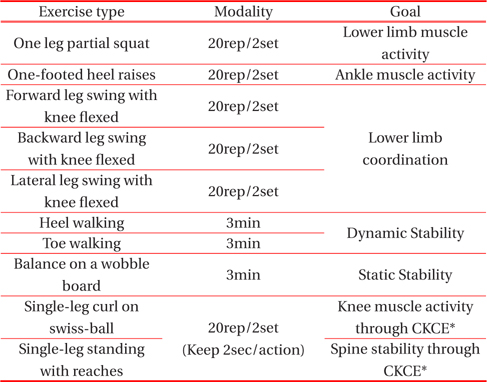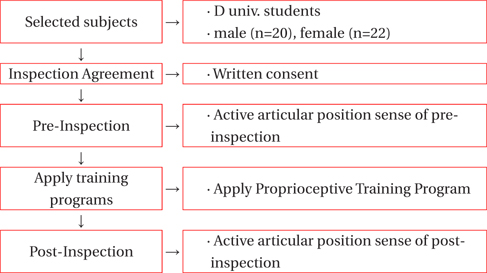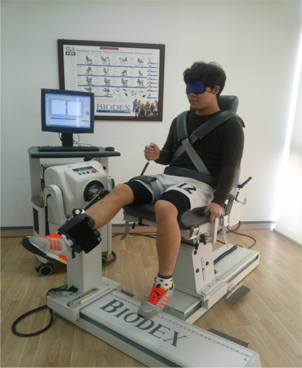



A proprioceptive function is defined as the ability to sense movement of the joint (kinesthesia) and function to static joint position sense [1,2]. This proprioceptive function is passed to the central nervous system by mechanoreceptors mainly present in the skin, articular membrane, and muscle, and plays an important role, especially in articular stability [3]. In joints, the muscular receptor plays the role of converting mechanical loads to afferent stimulation, and is combined with an advanced form of high-level exercise through this, to generate the muscle contraction reflex.
As a result, it plays the role of providing more improved articular stability. On the other hand, it has been reported that functional exercise to improve the proprioceptive function should be included in a rehabilitation program, because injury and damage of the muscleoarticular system lower this neuromuscular feedback system [1,4].
Also, function degradation of the muscle and nerve for movement control causes musculoarticular defects, leading to chronic instability [5]. Several previous studies have reported neuromuscular control training to improve proprioception with muscular strength, muscular endurance, and flexibility during rehabilitation exercise as very important factors, because degradation of the proprioceptive function is closely related to musculoskeletal injuries during physical activities, as well as degenerative change of the joints, [6-8]. This proprioception and neuromuscular control training is essentially applied to the rehabilitation process, to ensure that after injuries, athletes can perform certain exercise behaviors smoothly [9]. In addition, the maximization of exercise ability through improvement of balance and proprioceptive function is a very important factor for professional athletes, as well as ordinary people, and can significantly contribute to dynamic joint stability during day-to-day activities. TDPM (Threshold to Detection of Passive Motion), JPS (Joint Position Sense), and Standing Balance are mainly used for assessing the proprioceptive function; and among them, the TDPM method is mainly used [10,11]. On the other hand, isokinetic equipment, such as Biodex System 3pro®, has been simply limited to the assessment of muscle strength and muscle endurance, and there are few studies on the assessment of the isokinetic principle applied to the proprioceptive function that target ordinary people.
Thus, the purpose of this study is to conduct an analysis by using Biodex System 3pro® equipment, in order to identify the impact of a one-time pelvic limb proprioceptive function improvement exercise program on the active articular position sense (AAPS) function of ordinary people, and through it to develop effective proprioceptive exercise programs.
The subjects of this study were at D university, and comprised a total of 42 physically healthy people in their 20s, of 22 men and 20 women. The subjects were healthy university students without orthopedic diseases and metabolic diseases, and this experiment was conducted only after fully explaining the contents, experiment method, and purpose of this experiment to subjects, and having them give written consent to voluntary participation in the experiment. The physical characteristics of the subjects are shown in Table 1.
[Table 1.] Physical characteristics of subjects.

Physical characteristics of subjects.
The experimental procedure of this experiment is as shown in Fig. 1.
2.3 Active articular position sense function on knee extension
In order to assess the proprioceptive function in this study, we used the Biodex System 3 Multi-Joint Testing and Rehabilitation System (Biodex Medical Systems, Inc, Shirley, NY). As shown in Fig. 2, we measured the active articular position sense on knee extension. After bending the knee by 90° sitting on test equipment, a tester closed the subject’s eyes and extended their knee, told the subject to hold a specific angular 30° position, and then let the subject go back to the ready position, and measured if the subject sensed the joint position of 30° accurately, by pressing the ‘stop’ switch, when he or she had extended it actively, and judged it had reached 30°.
2.4 Flexibility and balance test
Sending forward was carried out by using a long sitting sending forward meter (TAKEI, T.K.K.5111, Japan). We measured it by letting the subjects bend their upper body with both their feet spread, and both arms stretched forward as much as possible, and pushing the measuring board. We carried it out a total of 2 times, and measured up to the unit of 0.1 cm, with the highest level of cm unit. In order to measure balance, we performed a closing eyes and standing on one leg test, and measured the time when the subjects closed their eyes as soon as they started and their foot touched the ground, after they put both hands on the crista iliaca, fixed their eyes to the front, and supported themselves with a comfortable foot. After measuring a total of 2 times, we measured up to 0.1 second with long time as the second unit.
2.5 Proprioceptive Exercise Program
A proprioceptive exercise program is a program to improve the active articular position sense function, and mainly consists of exercises for neuromuscular activation of the pelvic limb. Also, it is composed of programs to continuously improve the balance and AAPS function of the pelvic limb, by activating the reflexes of the central nervous system against external stimuli. The specific programs are shown in Table 2.
[Table 2.] Complex rehabilitation exercise.

Complex rehabilitation exercise.
The gender mean and standard deviation were calculated for each variable before, and after the experiment. To find out changes in balance and flexibility, AAPS functions of the left and right knee were determined according to the experimental treatment, by carrying out a dependent paired t-test. After calculating the T values, significance probability was obtained according to the degree of freedom, and the analysis was carried out by setting the statistical significance level (α) to 0.05.
3.1 Articular Position Sense Function
Changes in the AAPS function of the knee according to gender are shown in Table 3.
[Table 3.] The difference of Knee angle (˚) between pre- and post-test (Mean±SE).

The difference of Knee angle (˚) between pre- and post-test (Mean±SE).
Before and after conducting the proprioceptive exercise program, we measured and compared the 30° articular position sense at the knee, and as a result, the error of both knee angles turned out to be reduced for both men and women after the program, compared with before. In the case of women, the left knee angle was reduced by 6.26±1.45° from 10.84±1.58° to 4.58±0.58°, and the right was also reduced by 6.69±1.53° from 10.59±1.52° to 3.89±0.72°, showing statistically significant differences (t=4.30, p<.0003). Before the program, men showed a smaller error than women. In the case of the left knee angle, the error decreased by 2.95±0.66° from 5.73±0.66° to 2.78±0.37°, and that of the right also decreased by 2.46±0.69° from 5.45±0.63° to 2.98±0.44°, showing statistically significant differences. Before the program, women showed about two times larger errors than men, and accordingly, the improvement also turned out to be high.
The changes in flexibility and balance according to gender are shown in Table 4. The flexibility and balance were measured before, and after the proprioceptive exercise program, and as a result, both turned out to be improved. In addition, statistically significant differences were found in all other factors, except men’s flexibility.
[Table 4.] The difference of flexibility and balance between pre- and post-test (Mean±SE).

The difference of flexibility and balance between pre- and post-test (Mean±SE).
In the case of women, the flexibility was improved by 2.74±0.75 cm from 13.36±2.10 cm to 16.10±1.64 cm, and the left and right balance also increased by 3.63±1.01 sec. and 4.08±0.84 sec., respectively, and statistically significant differences were shown (t=3.57, p<.0019; t=4.81, p<.0001). The flexibility of men was improved by 1.66±1.04 cm from 11.27±2.26 cm to 12.93±1.92 cm, but there was no statistical significance (t=1.58, p<.1296). The left and right balance increased by 2.24±0.84 sec. and 1.63±0.53 sec., respectively, and showed statistically significant improvement (t=2.66, p<.0156; t=3.04, p<.0067).
Traditionally, isokinetic equipment, such as the Biodex System 3pro®, is used to assess muscular strength and muscular endurance. However, we tried to assess the proprioceptive ability, to activate the features of articular position sense and kinesthetic sense for joint movement (kinesthesia) in combination [1]. The proprioceptive ability is very important in preventing the potential risk of injury, and improving the factors involved in performing certain actions, while exercising and improving incorrect biomechanical movements. Therefore, simple proprioceptive enhancement programs should be included in day-to-day exercise methods, and this can prevent orthopedic damage and secure muscle strength improvement and the stability of joints, through smooth interaction between the nervous system and the musculoskeletal system. Thus, we discuss the findings of this study of APS (Articular Position Sense) ability through active knee extension action, which we conducted to find out the effect of proprioceptive exercise, based on a number of previous studies.
To find out the proprioceptive ability of the knee, Pincivero et al. [12] carried out a test to find the articular position at various degrees of knee joint of 15°, 30°, 45°, and 60°, by using isokinetic equipment, and reported that proprioception has an impact on reproducing a given angle. Courtney et al. [13] evaluated the proprioception function using isokinetic equipment targeting 25 healthy adults, and reported that the high intensity exercise group showed better gonocampsis 40° position sense ability than the control group. This significantly coincides with the results of this study that the articular position sense ability was significantly improved while conducting active knee extension actions, after one time proprioceptive exercise.
On the other hand, Ageberg et al. [14] reported that conservative early treatment was carried out targeting 56 patients after ACL (Anterior Cruciate Ligament) damage, and muscular strength then recovered to normal, but kinesthesia did not recover. It can be considered that an appropriate proprioceptive exercise program of early rehabilitation should be conducted first, in order to contribute to the recovery of the proprioceptive function, and act as an important factor in the mechanoreceptors of joints. As shown above, this study identified the following fact: proprioception exercise should be included in the process of rehabilitation, because it prevents injuries and restores damaged kinesthesia, and it is very important to apply it to the initial rehabilitation, if possible.
On the other hand, flexibility and balance ability were evaluated in this study, and as a result, both turned out to be significantly improved. This is consistent with Kisner et al. [15] reporting that the stability of the trunk, as well as appropriate flexibility, should be controlled for balance control.
This can be considered to be the positive effects shown by proprioceptive exercises that stimulate the mechanoreceptors of soft tissue joints, such as joint capsule, tendons, ligaments, cartilage, at the same time. The meaning of this study was to easily assess the proprioception function required for safety and injury prevention of joints and muscles, targeting ordinary people, by using Biodex System 3pro® equipment, based on the findings of this study.
Thus, in order to develop objective rehabilitation programs, ongoing research on proprioceptive exercise programs targeting ordinary people will be needed, and these rehabilitation exercise programs are considered to be variously presented, by using Biodex System 3pro® equipment.
In order to find out the impact of proprioceptive exercises on the position sense of the knee joint using Biodex System 3pro®, we conducted an experiment targeting a total of 42 people, 22 men and 20 women. After applying proprioceptive exercises, we found out changes in balance and flexibility, and the position sense of the active joint according to gender. The results are as follows.
After proprioceptive exercises in both men and women, AAPS out to be significantly improved (p<.01). In the case of women, the flexibility turned out to be significantly improved (p<.01), but men showed only a tendency to improve. In addition, in a balance test, both men and women showed significant increase (p<.01).





